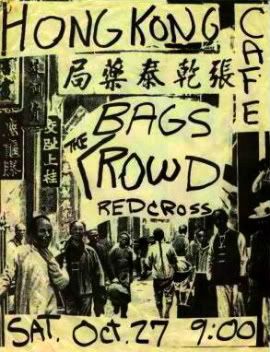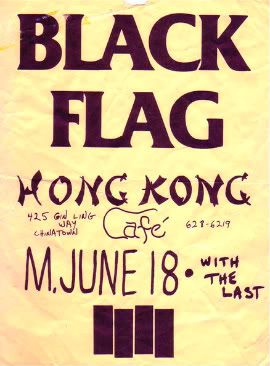
Watching The Decline of the Western Civilization today (on Youtube), I learned about the importance of the venues in Chinatown in the emerging punk and hardcore music scene in east LA in the late 1970s and early 1980s. Many bands performed at these two Chinatown venues: Hong Kong Cafe and Madame Wong. Both restaurants/clubs are no longer in business. The competition between the two venues was dubbed as the “Chinatown punk wars” by the LA Times in 1979.
After a quick search on Google, I found a few blog posts on this interesting historical moments, most of which are documented on a blog about The Go-Go’s, an all-girl punk / new wave band that emerged around that time. These blog posts include current (circa late 2000s) narratives around the venues and pictures of the buildings where the restaurants and clubs existed. I also found a short, pointed interactive piece (consisting of map, text, and audio interview) on this historical moment created by KCET as a part of the Restoring Chinatown series. Facebook has a group dedicated for individual users to post media related to each of the venues (Madame Wong | Hong Kong Cafe). Also on Myspace, there is a page dedicating to the memorializing of the Hong Kong Cafe. On the academic side, I found a paper abstract written by a film and media studies PhD candiate at UCLA named Laurel Westrup. She gave the paper at EMP Pop Conference earlier this year.

I’m strangely attracted to this topic. But I’m not sure what my attraction entails. I know that it’s definitely related to my fascination with LA and excitement for moving to LA. I also think that this could be a seed for a new digital project. The KCET’s project can be a start of what I conceived as an in-depth interactive investigation of the interconnections between music of the “underground,” immigrant communities, and place, to unfurl the hidden discourses behind the often-times white-centered punk rock narratives.

Also, I’m interested in unraveling the immigrant restaurateur’s side of the story. The LA article depicts Esther Wong, the proprietor of Madame Wong, as an uptight club owner who was interested in booking bands that wouldn’t draw a rowdy crowd. Specifically, Wong was known to book bands identified as “new wave,” a term used to describe a version of punk rock sound catering to the mass. Wong had a policy of excluding bands who have played at the competing venue Hong Kong Cafe. In the 1979 article in the LA Times, Wong was quoted for saying, “If a band plays the Hong Kong one night then comes to me the next, no – I wouldn’t book them because that would be bad business.” The booking agent Barry Seidel at the Hong Kong Cafe appeared to have a more populist attitude. In response, Seidel expressed that a good band would draw an audience regardless of where they played the night before. The opposition between Wong and Seidel seems racialized as Wong was portrayed as the Dragon Lady [part 2 of Summa and Spurrier’s video series]; and Seidel seems liberal, “reasonable,” and “punk-rock,” resonating with the punk ethos of embracing the abject. The Hong Kong Cafe explicitly welcomes the bands rejected by Madame Wong. This opposition puts Wong on the money side, and Seidel on the music/punk side of the ideological binary upheld by many punk rockers.

Going beyond a white-centered narrative, the Latino presence in LA punk scene has been recognized. Michelle Habell-Pallán has researched the Latino/a experience of LA punk rock. [Read about Latino punk in the 1990s.]
I wonder what the Asian American experience of punk rock in LA might have been? In light of the Chinatown as an important site of the punk emergence, how does this factor into the relationship between punk rockers (disenfranchised youth, white, Latino, black, and Asian Americans) to the Chinese club owners? Even in Virginia, from my experiences of interacting with local music scenes in Richmond and Charlottesville, I’ve noticed that many of the music venues are Chinese-owned, for example, Nancy Raygun in Richmond and the Outback Lodge in Charlottesville.

Also, how does playing in Chinatown affect the sound and ideologies of these punk rock bands? There are lots of songs about the food, culture, and people of Chinatown in rock music history. The Siouxsie and the Banshees have a song — “Hong Kong Garden” — about a restaurant in Chinatown. According to Wikipedia, Siouxsie Sioux has mentioned that the song is a tribute to a Chinese restaurant that the band used to frequent. The song is also a reaction to skinhead punks’ terrorizing of the Chinese workers at the restaurant. David Bowie sings a song about “China Girl” and the official music video of the song is set in a Chinatown. In both instances, the song enlists orientalist musical references including gongs, pentatonic modes, and dotted rhythm to contrive a shallow Chineseness for the non-Chinese audience. These musical tokens, especially when infused with the power chords, omnipresent in songs with punk sensibility, have made a unique sonic space in rock music history.
When I get to LA, I will be in the field with the GPS tracking device on my phone turned on, exploring Chinatown with a set of new intentions. I will bring my digital audio recording device with the hope to collect some stories from the Chinese business owners in the area.


 bio
bio
3 Comments
Pingback: Music links of interest | Infotropism